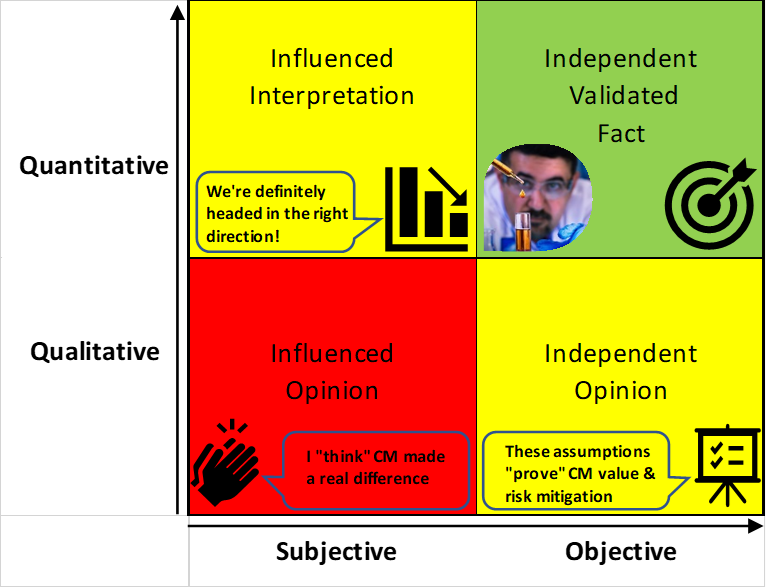Think how frequently we go through the endless cycle of debating whether Change Management really made material impact on a project, trying to build consensus on measures for success and aiming to connect the dots between Change Management and business performance ….it’s enough to make anyone’s head spin!
Well as Change Management practitioners, we faced this challenge on a regular basis and called it ‘The Change Management Conundrum’. To address such situations, we developed and refined our CM engagement approach to build a bridge between business purists focused on quantitative business KPIs and Change Management measures of success. The challenge and solution are described in more detail below with a supporting Change Management Effectiveness scorecard that we hope you can easily adopt to bridge the gap on your own engagements.
The Change Management Conundrum: Too often judgements on CM’s value addition, risk mitigation, user adoption and so on are only based on subjective surveys, polled statistics and professional opinions. Evaluations and sentiments gleaned through focus group sessions, one-on-one interviews and ever more frequently occurring virtual discussions are perceived to be marred with emotion, skewed, or dominated by individual personalities. Rightly or wrongly, such approaches for measuring Change Management Effectiveness are often considered by purists to lack the robust and systematic mechanisms used to measure direct impact on business performance.
Although many Change Management practitioners would disagree with the business purists and indeed many such statistical techniques are well documented in publications such as Prosci’s ‘Best Practices in Change Management’, ultimately there is a need to increase client satisfaction for those who sit on the other side of the fence to separate measurable facts from perceived assumptions.
Game plan: Faced with such recurring resistance over many years, on a broad range of projects, we finally sought solace from our colleagues in other somewhat related disciplines that incorporate CM principles within their own methodologies. These included Process Optimization, Lean Six Sigma, and User Experience (UX). We wanted to understand and learn about the litmus tests they used for demonstrating value and benefit to their clients to determine if we could adopt similar mature, tried, tested, and accepted techniques on Change Management engagements.
In a nutshell, similar to the other disciplines, as CM practitioners we need to move further towards the top right quadrant to gain greater client acceptance and credibility for the value delivered by Change Management. We can achieve this through tangible and measurable CM intervention impact data that ties directly to business performance KPIs supplementing the valuable subjective and qualitative information that we already tend to collect to measure Change Management effectiveness.
Change Management. We can achieve this through tangible and measurable CM intervention impact data that ties directly to business performance KPIs supplementing the valuable subjective and qualitative information that we already tend to collect to measure Change Management effectiveness.
Learning from others: Teaming with the other disciplines was a natural next step since over the last several years we had been increasing our collaboration with parallel workstreams specializing in Process Optimization, Lean Six Sigma and more recently User Experience during design, testing and user acceptance. With the exception of User Experience considered to be a relative newcomer, Process Optimization and Lean Six Sigma had mature and accepted methods and tools for measuring and demonstrating their contribution on projects. We therefore narrowed our field of study to measuring Change Management Effectiveness on Process Optimization and Lean projects to determine how best to measure and relate CM’s value add and benefits directly to business performance. In particular, we wanted to overcome the rhetoric that conjecture was the only means of showing value of Change Management on engagements given the absence of business metrics being directly tied to CM activities.
User Experience brought an interesting nuance to the table and our mindset moved beyond customer satisfaction towards focusing on a positive customer experience before, during and after the change to drive future state viability and sustainability. Afterall, a positive ‘customer experience’ should encapsulate all aspects of a customer’s needs and desires incorporating much more than just ADKAR, customer satisfaction or targeted business KPIs.
Key perspectives:
- Define Change Management Effectiveness KPIs to capture the ‘people experience’ and also map these to your business performance measures and targets. This will help to explain the impact and benefit of CM interventions from a business operations point of view
- Be consistent in using and measuring your CM Effectiveness KPIs so that over a period of time you gain experience of what good business looks like balanced across the CM measures. This will help you to benchmark and assess risk within the current & future states as well as the cause-effect of CM interventions.
- UX recommendations overwhelmingly suggest measuring Effectiveness, Efficiency and Engagement. While Whitney Quesenbery, 2003 includes Error Tolerance and Ease of Learning to support a multi-dimensional viewpoint
The solution: To support Change Management practitioners in successfully moving towards the top right quadrant with a consistent and systematic approach that will be plausible and acceptable for operational and business executives we deployed the scorecard below.
Change Management Effectiveness Scorecard:

The scorecard meets our objectives by defining and tying Change Management Effectiveness measures with business operational KPIs. Furthermore, the scorecard allows capturing financial and experiential data and combines this with sentiment information that can be collected through a variety of traditional or high-tech mechanisms e.g., through surveys, interviews, or focus groups. This can be used to baseline the current state, measure the gap with the desired future state and to make interim measurements to gauge progress during engagements to provide targeted viewpoints to management.
As you will see the scorecard tightly links measuring the impact of CM interventions, termed ‘Change Management Effectiveness’ and Business operational KPIs demonstrating that they are interdependent and can be measured interchangeably. And by so doing the CM practitioner in collaboration with project management can easily separate the quantifiable operational facts reflecting Change Management Effectiveness from mere assumptions relating to change management impact.
Try applying the scorecard on your current and future engagements not only as a means of demonstrating CM Effectiveness but also to build a databank that will eventually grow into a benchmarking database specific to your organization.
References:
- Best Practices in Change Management, 2014 Edition, Prosci Benchmarking Report, ISBN: 978-1-930885-64-6
- Tristan Boutros and Tim Purdie – 2014. The Process Improvement Handbook. A Blueprint for Managing Change and Increasing Organizational Performance. McGraw Hill. ISBN: 978-0-07-181766-0
- Subir Chowdhury, 2002. Design For Six Sigma. The Revolutionary Process for Achieving Extraordinary Profits. Dearborn trade Publishing. ISBN: 0-7931-5224-0
- Dassault Systemes 2014, High-Tech, Designing the User Experience, White Paper
- INTERACTION-DESIGN.ORG
- Whitney Quesenbery, 2003, Proceedings of the UPA 2003 Conference, June 23-27, 2003

























